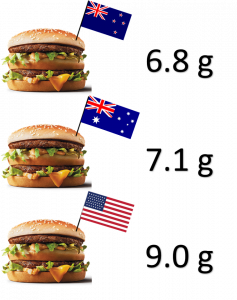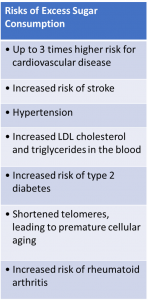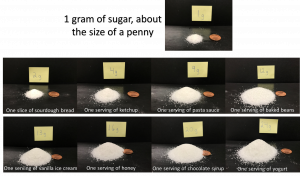Sugar-Coated
How an evolved taste has taken over modern food consumption
Jordan Crabtree
Ice cream for breakfast. Chocolate sauce on pasta. Vegetables slathered in honey. Though these sound like childhood dreams come true, most reasonable adults would be quick to shoot these ideas down, on account of the obviously high sugar content present with little to no nutritional benefit. And yet, parents pay no mind to a serving of low-fat yogurt in the morning, two portions of pasta sauce with a plate of spaghetti later that night, or a serving of baked beans as a side.

While most would be able to point at the average soda as a major source of sugar in the American diet, many products that one would not associate with the compound or even a sweet taste at all nevertheless have very high amounts. For instance, a serving of canned baked beans at the grocery store has roughly 12 grams of sugar in it, and a single-serving container of low-fat yogurt has a whopping 24 grams of sugar. A single tablespoon serving of ketchup contains 4 grams of sugar, and a serving of pasta sauce contains 9 grams of sugar (nutrition facts found on products at Walmart). Of course, along with these figures comes the discrepancy between serving size and actual portion size, which the American Heart Institute claims has “grown significantly” in recent years (Portion Size, 2015).
Americans love sugar and are in many ways justified for doing so. As a species originally dependent on hunting and gathering to obtain all of the nutrients necessary for early hominid life, energy-dense foods were a blessing during our early days. Sugar-based plants had many benefits in comparison to their alternatives, such as providing much more energy per serving and being molecularly primed for storage as fat for when food was not as plentiful (Lieberman, 2014). This served the ancient hominid well, however, this preference has evolved a darker side in the modern era of reduced physical activity and an excess of food. Our tastes evolved to motivate us to eat more sugar when food was scarce, however, this has resulted in our eating too much now that it is readily available. This evolution has thus given rise to industries ready to reap the profits of selling sugar in many products that the average person wouldn’t expect to be filled with it.
The disconnect between what consumers think is in their food versus what is actually in it has thus shifted power to favor industries that most don’t associate with contributing to the American obesity epidemic or the dietary sugar problem. The American Heart Association recommends an average daily intake of roughly 37.5 grams of added sugars for men, and 25 grams for women (Added Sugars, 2018), however, given the little information we are provided outside of basic numbers on a nutrition label, it is often difficult for the average person to make sense of exactly how much necessary sugar they are being sold by food-producers on a daily basis. One such industry that serves as an example of this disconnect is the fast-food sector, and specifically its targeting of Western eating habits.

Companies such as McDonald’s have become the epitome of standardization in restaurant experiences, ingredients, and overall consistent quality of food. This is for the most part true in the States, however, it is not universal. For instance, McDonald’s restaurants in India do not serve beef, and there are many purely kosher McDonald’s in Israel. As a chain, the company capitalizes on all possible methods to sell the right type of food to the right people, which is precisely why a typical Big Mac in New Zealand contains 6.8 grams of sugar, one in Australia contains 7.1 grams of sugar, and American Big Macs boast 9 grams (Data collected from regional McDonald’s websites for each country). Food-producers that don’t advertise nutritional content to the degree that they advertise taste and convenience thus have an advantage in the vast majority of their consumers (i) not checking the nutritional content of the food sold, (ii) being unaware of the recommended sugar intake per day, or (iii) not knowing exactly how bad sugar actually is for them. As a result, franchises like McDonald’s and food-processing companies like Nestle can use massive quantities of sugar in their products relative to what is necessary in order to trick consumers’ evolutionary roots into purchasing more.
Outside of evolutionarily-acquired reasons for loving sugar, American diets have also fallen victim to more modern routes of persuasion in regard to sugar consumption. In one of the most controversial dietary manipulations to date, in 1967 the New England Journal of Medicine published a literature review put together by Harvard researchers which “singled out fat and cholesterol as the dietary causes of [Coronary Heart Disease] and downplayed evidence that sucrose consumption was also a risk factor” (Kearns et al., 2016). With this, institutions responsible for setting dietary guidelines for the American public encouraged citizens to reduce their consumption of fats, and replace them with sugars whenever possible. This, in turn, created a number of consumer and industry mindsets that demonized all types of fats in the diet, yet championed sugar as a healthier alternative.

Interestingly enough, additional studies have since proven these claims to be blatantly false, suggesting instead that replacing fats with sugars in the diet is actually much worse for heart health than not. On top of increasing the risk of heart disease, many types of sugar contribute to health issues that aren’t produced by eating fats (Dinicolantonio et al. 2016). Increased sugar consumption has been linked to higher blood pressure, weight gain, increased chronic inflammation, diabetes, and even fatty liver disease (Sweet Danger, 2019), and all of these factors serve the ultimate goal of increasing the risk of cardiovascular disease at both greater intensity and earlier onset than diets lower in sugar.
More recent investigations have even found that the originally published false literature review was funded almost entirely by the Sugar Research Foundation, an institution that benefitted greatly from increased sugar consumption and a negative public image of fats. In fact, these investigations uncovered evidence that this foundation not only set the objective of the literature review, but also cherrypicked the research that was to be reviewed and received drafts of the work for approval before it was sent for publication (Kearns et al., 2016).
Unfortunately, the misinformation published in 1967 was enough to change American diets permanently in many ways. Confusion among consumers has resulted in unreasonable attitudes towards many fats that are important for a variety of bodily functions, and a view of sugar as less harmful than it really is. As a result, companies within the sugar industry – and by extension, many food producers – have benefitted greatly from this one case of manipulation. By not only withholding information from the public, but actually pushing false information through the means of established research facilities and peer-reviewed literature, these benefits arose to the detriment of American consumers.
Though much time has passed since these events took place and a considerable amount of research has provided evidence contrary to the results of the funded review, sugar consumption still remains a major health problem for the American public. Companies have leveraged a near-universal human drive to sell more of their products, and have faced little to no consequences in the process. Though new nutritional label regulations have been passed in recent years, this is still a flawed solution based on its reliance on consumer knowledge on the subject. Unfortunately, increasing knowledge as a consumer is likely the only route any one person can take in the near future. People, at the very least, need to understand that though sugar is extremely common in most food-products, that doesn’t mean it is in any way healthy.

Sugar, for the most part, is not as necessary in many foods as companies would like consumers to believe, and a prime example of this lies in bread. According to an interview with David Linz, Ph.D, many of the sugars and fats found in bread are not completely necessary ingredients, and instead are only present to provide consumers with the taste they’ve become accustomed to. Though Dr. Linz is not formally involved in any sugar or nutritional research, he eats almost exclusively bread he makes at home and stays familiar with current research in the field. In an interview, he detailed the ingredients of the sourdough bread he bakes to be water, salt, wheat flour, and a “starter” consisting of a natural culture of these ingredients and a mixture of yeast and lactobacilli that provide the flavor of the bread. In comparison, a loaf of sourdough bread at Walmart would contain these ingredients, as well as 2 grams of sugar per slice of bread (Walmart.com). While this may be only one product with a small amount of extra sugar, this subtle difference speaks to the trend of many food-manufacturers today: adding sugar makes products sell better for a variety of reasons, to the detriment of their consumers.
Dr. Linz, when asked for his thoughts on what any one person can do to limit sugar and other harmful food additives, suggested, “When you go to the grocery store, try and have 90% of what you’re eating come from the periphery.” “When you go to the grocery store, try and have 90% of what you’re eating come from the periphery.”Due to the fact that the lower-sugar foods like meat, produce, bakery-style bread, and dairy items are found outside of the aisles of the store, sugar intake can then be limited, or at least regulated by the consumer themselves by purchasing mostly these. Because, “most people today don’t know what ingredients actually make up their food,” Dr. Linz suggested that one cooks for themself whenever possible, and makes an effort to consider how any purchased food was prepared and preserved. It is also worthwhile to consider how something should really taste when purchasing food. Should bread really be sweet? What about canned beans or coffee? Sugar can hide in a number of products that we’ve crafted to be sweet but naturally wouldn’t be anywhere near this taste.
While acquiring a taste for sugary foods may have been pure Darwinism at work, the evolution of the American diet to include vast amounts of sugar has ultimately led to a less healthy species in the modern age. As a result, those involved in food production and processing have capitalized on consumers’ instinctual pursuit of sweet, long-lasting foods, going so far as to manipulate scientific research to aid their cause. Though nationwide policy changes are likely years away, the average consumer can still take a few steps to preserve their own health. By carefully monitoring the amount of sugar one consumes, seeking out alternatives to foods that are high in the substance, and generally understanding what products need sugar versus where it’s just there for taste or profit, consumers can work to become more aware of the primal instincts companies may actually be leveraging to sell their products.
References
Added Sugars. (2018, April 17). Retrieved November 20, 2019, from https://www.heart.org/en/healthy-living/healthy-eating/eat-smart/sugar/added-sugars
Health Risks of Sugar, How to Avoid Added Sugar. (2015, August 3). Retrieved December 10, 2019, from https://www.berkeleywellness.com/healthy-eating/nutrition/article/sugar-making-us-sick.
Boseley, S. (2017, April 18). First US sugar tax sees soft drink sales fall by almost 10%, study shows. Retrieved November 20, 2019, from https://www.theguardian.com/society/2017/apr/18/first-us-sugar-tax-sees-soft-drink-sales-fall-by-almost-10-study-shows.
Dinicolantonio, J. J., Lucan, S. C., & O’Keefe, J. H. (2016). The Evidence for Saturated Fat and for Sugar Related to Coronary Heart Disease. Progress in Cardiovascular Diseases, 58(5), 464–472. doi: 10.1016/j.pcad.2015.11.006
Kearns, C. E., Schmidt, L. A., & Glantz, S. A. (2016). Sugar Industry and Coronary Heart Disease Research. JAMA Internal Medicine, 176(11), 1680. doi: 10.1001/jamainternmed.2016.5394
Lieberman, D. (2014). The story of the human body: evolution, health and disease. New York: Vintage Books.
Portion Size Versus Serving Size. (2015, March 20). Retrieved November 20, 2019, from https://www.heart.org/en/healthy-living/healthy-eating/eat-smart/nutrition-basics/portion-size-versus-serving-size.
The Sweet Danger of Sugar. (2019, November 5). Retrieved December 10, 2019, from https://www.health.harvard.edu/heart-health/the-sweet-danger-of-sugar
